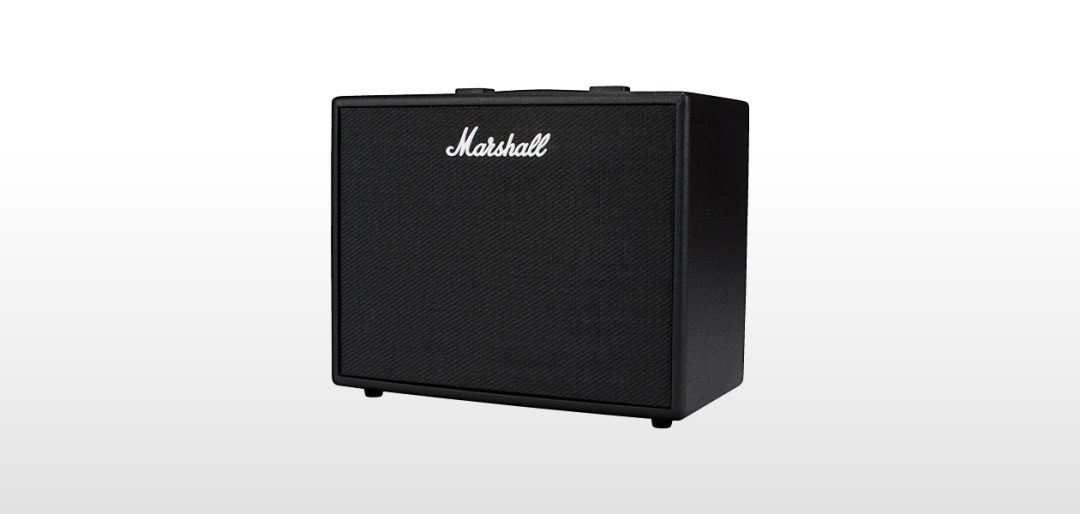Marshall is among the most recognized names in amplification. While best known and most favored for their iconic tube amplifiers, the company has never shied away from keeping current. Enter the Code series of digital modeling amps offering a variety of sounds and effects in a single unit. Understand some of the ins and outs of a contemporary digital amp in our Marshall Code 50 review and rundown.
Meet the Marshall Code Range
The Code range isn’t a huge one, though that’s by no means a critique. It consists of the Marshall Code 25 and Marshall Code 50, with the number referring to the amount of watts each amp has. Both are digital combo amps with the 25 utilizing a single 10″ speaker and the 50 sporting a 12″ speaker. There are also the discontinued Code 100 and Code 100h (head) amps.
- SEE ALSO: The 10 Best Small Tube Amps for Home Use
- SEE ALSO: The 11 Best Virtual Amp Sims [Free & Paid]
The real heart of these little monsters is, of course, the modeling section, which allow users to combine different Marshall preamps, power amps, and speaker cabinet emulations to find their unique sound. It also includes a couple dozen effects, so you can effectively craft a complete digitally modeled signal chain. First-time users can load up any of the 100 presets to start jamming right away, or you can dive in deep and engineer your own tone(s) for the most versatility.
Marshall Code 50 Review: How Does It Stack Up?
Our topdown perspective is that this is a notable little practice amp that’s a ton of fun to jam on the couch, on the road, or even in the office (if your workplace is cool like that!). It’s relatively affordable, highly versatile, and does a nice job of establishing itself against the competition. Worth noting is that it does seem to have enough juice to keep up with a band and even perform in a live setting, though that may not necessarily be its intended use. Your mileage may vary!
Marshall Code 50 Notable Features
The first and most notable feature is the actual modeling technology onboard. It consists of 14 classic Marshall preamp sections, including emulations of the JCM800, Bluesbreaker Plexi, and the Silver Jubilee. From here, you have four power amp emulations that cover both vintage and modern British and American sounds. At the output stage you have eight speaker emulations covering everything from a punch 1×12″ to a roaring 4×12″. Somewhere in the middle there are 24 digital effects to complete your tone.
Another noteworthy feature is remote USB or Bluetooth control. With the included Marshall Gateway software you can dial in sounds over USB, or you can run the app on your phone over Bluetooth. That’s just a really convenient inclusion that lets you sit the amp on a shelf or coffee table and create tones from the couch.
Construction & Materials
Marshall typically doesn’t skimp in the construction and materials department. The Code 50 is a fine example of that — for a travel-friendly amplifier, this sucker weighs a hefty 30 pounds and by no means feels cheap or flimsy. There’s really no gripe with the build quality, and anyone purchasing it wouldn’t need to worry that it would somehow fail or break down after years of playing.
The Speakers
The speaker in the Marshall Code 50 is an unnamed 12″ of their own design. Using a “brand-name” speaker like a Celestion, for example, would most likely drive up the price and not necessarily help a modeling amplifier in a tremendous way. For all intents and purposes, it gets the job done. If you decide to use the aux input and jam along to your favorite tunes, you’ll notice that the speaker isn’t the most hi-fi in the world. However, that ultimately comes down to it being a guitar speaker.
Onboard Effects
24 onboard effects are a lot to play around with. By and large, they sound authentic and very high-quality. The range you can get out the Code 50, between the amp models and effects, is impressive. If you intend on using it as a practice amp, you’d find more than enough versatility for essentially any genre.
How Does the Marshall Code 50 Sound?
The Code 50 stacks right up with other contemporary modeling amps and does a convincing job of emulating some of the finest Marshall amplifiers ever made. The presets alone are highly useable and reminiscent of plugging into the real thing. Modeling technology has certainly come a long way, and continues to evolve, and it’s apparent with the Code 50 that Marshall intends to utilize every new innovation in meaningful way that translates to better sound quality.
Are There Any Drawbacks with This Modeling Amp?
Arguably the biggest downside to the Code 50, or any digital modeling amp, for that matter, is how it interacts with different guitars. You’ll likely find that it tends to tame any unique characteristics of the given instrument, and homogenizes the sound across the board. This could be an advantage for beginners who may not have the nicest instrument yet at their disposal, as it will definitely flatter the guitar. But if you’re hoping to hear the nuance of your collection, this may not be it.
The Marshall Code 50 Offers a Vast & Versatile Amp Sound for the Price
Overall, the Marshall Code 50 is a fantastic value. We actually like that it doesn’t try to do too much like some other modelers. 14 amp models are plenty without feeling verbose. It’s easy to set up a playable tone without fighting the technology, which is always a plus. Still, there’s a massive range of versatility for guitarists of every genre. The Code 50 is a decisive win.
